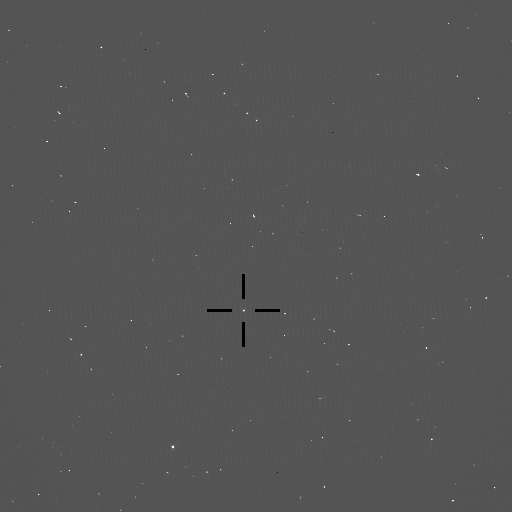← back to ‘Outer Moons of Saturn’
![]() Albiorix is ∼29 kilometers (±5 kilometers) in size and the third largest irregular moon of Saturn. It has been discovered in 2000 joint with eleven other outer moons. Albiorix’s mean distance to Saturn is ∼16½ million kilometers, with one revolution around the planet on a prograde orbit requiring 2 years, 1 month and 3 weeks. Albiorix is the largest member of the Gallic family.
Albiorix is ∼29 kilometers (±5 kilometers) in size and the third largest irregular moon of Saturn. It has been discovered in 2000 joint with eleven other outer moons. Albiorix’s mean distance to Saturn is ∼16½ million kilometers, with one revolution around the planet on a prograde orbit requiring 2 years, 1 month and 3 weeks. Albiorix is the largest member of the Gallic family.
From our Cassini measurements, the rotation period was determined to 13 h and 20 min ± 2 min. The Albiorix lightcurves show a large brightness variation, indicative of a rather elongated shape of this moon.
Fig. (left): Short animation of Cassini images of Albiorix while moving through constellation Bootes on 28 Jan 2017 (21 frames; time span: 3:18 h; exposure times: 10 sec; range: 8.3 million km; Cassini orbit: rev 259). In the first image, the object is marked by a black cross. The background stars move quite rapidly through the field of view because the camera of the fast moving Cassini spacecraft was tracking Albiorix, and Cassini was close to its orbit’s periapsis. The slight horizontal jitter of Albiorix is due to improper tracking at the arcseconds level. Flickering bright spots or streaks stem from cosmic-ray hits on the camera’s CCD detector, fixed bright or dark pixels are incorrectly calibrated hot or cold pixels on the CCD, respectively. The space background, in reality pitch black, is displayed in dark gray because this makes visibility of the object easier. Image IDs: N1864300447 to N1864312316.
Fig. (right): Modified DIGIT plot showing Saturn’s largest moons, the Cassini spacecraft, and Albiorix on 18 Jan 2015 while the observation phase angle dropped to 5°. The Sun is up.
This page is intended to compile much of our knowledge of Albiorix in compact form. Its main focus lies on the documentation of my Cassini-ISS work (observation planning and data analysis). In the 1st section, it also provides general information obtained from other work, like discovery circumstances and orbital and physical parameters. It does not include the raw data (images or spectra) taken by the Cassini spacecraft, these are available at NASA’s Planetary Data System (PDS). For further reading on Albiorix and on irregular moons of Saturn in general, see the reference list at the end of this page.
This website is still under development. As soon as papers will be reviewed or other information will be processed appropriately, more content will be added. I will remove this note when the page will be close to completion.
Last update: 27 Apr 2022 — page content is best displayed on a screen at least 1024 pixels wide
(1) Astronomical and physical properties
| Moon name | Saturn range | Orbit period | Orbit direction | Size | Rotation period | Discovery year |
| Albiorix |
million km
|
years
|
prograde |
∼ km
|
h min
|
2000 |
Basic information about Albiorix is offered in tabular form:
(1A) Designations and discovery circumstances
(1B) Orbit parameters
(1C) Physical parameters (body properties)
![]() ← Tables (1A) to (1C) in text format
← Tables (1A) to (1C) in text format
Most fundamental values are highlighted in red. The notes offer explanations, calculations, accuracies, references, etc. The data were obtained from spacecraft as well as from ground-based observations.
(1A) Designations and discovery circumstances
| Moon name(1) | Albiorix | IAU number(3) | Saturn XXVI | First observation date(7) | 09 Nov 2000 | ||
| Moon abbrev. (TD)(2) | Alb | Provisional desig.(4) | S/2000 S 11 | Announcement date(7) | 19 Dec 2000 | ||
| SPICE ID(5) | 626 | IAU circ. announcement(7) | no. 7545 | ||||
| Also-used label(6) | S26 | Discoverers(8) | M. Holman et al. |
Notes for Table 1A:
(1) Albiorix’s name was announced on 08 Aug 2003 in IAU circ. 8177. It is taken from the Celtic mythology where Albiorix is identified with Celtic Mars.
(2) I use this 3-letter abbreviation in the diagrams of my publications simply for practicability reasons. These have no offcial character.
(3) Moon numbers are assigned by the International Astronomical Union (IAU)’s Committee for Planetary System Nomenclature. For satellites, roman numeral designations are used.
(4) Designation given to the object in the first announcement; the guidelines are explained here.
(5) SPICE is a commonly-used information system of NASA’s Navigation and Ancillary Information Facility (NAIF). It assists engineers in modeling, planning, and executing planetary-exploration missions, and supports observation interpretation for scientists. Each planet and moon obtained a unique SPICE number.
(6) ‘S’ for ‘Saturnian moon’ plus the roman numeral designation in arabic numbers are often-used labels for satellites. Not sure how official that is.
(7) The date of the photography wherein the object was spotted for the first time is given in the IAU circular released on the announcement date.
(8) The discoverer team included: Brett Gladman, JJ Kavelaars, Jean-Marc Petit, Hans Scholl, Matthew Holman, Brian Marsden, Phil Nicholson, Joe Burns.
(1B) Orbit parameters
| Orbit direction(1) | prograde | Group member(2) | Gallic | Dynamical family(3) | Gallic | ||
| Periapsis range(4) | 8.52 ⋅ 106 km | Semi-major axis(5) | 16.393 ⋅ 106 km | Apoapsis range(6) | 24.26 ⋅ 106 km | ||
| Semi-major axis(7) | 272 R♄ | Semi-major axis(8) | 0.110 au | Semi-major axis(9) | 0.250 RHill | ||
| Orbit eccentricity(10) | 0.480 | Orbit inclination(11) | 34.1° | Inclination supplemental angle(12) | 34.1° | ||
| Orbital period(13) | 785.5 d | Orbital period(14) | 2 y 1 m 3¼ w | Mean orbit velocity(15) | 1.52 km/s |
Notes for Table 1B:
(1) Prograde (counterclockwise as seen from north) or retrograde (clockwise as seen from north)
(3) Classification based on the a,e,i space in Fig. 1 and Table 2 in Denk et al. (2018)
(4) $r_{Peri}=a\cdot(1-e)$
(5) Orbit semi-major axis a, from JPL’s Solar System Dynamics Planetary Satellite Mean Elements website
(6) $r_{Apo}=a\cdot(1+e)$
(7) Saturn radius R♄ = 60330 km (100 mbar level)
(8) Astronomical Unit 1 au = 149 597 870.7 km
(9) Saturn’s Hill sphere radius $R_{Hill}=\sqrt[3]{m_♄/3m_☉}\cdot r_{♄↔☉}$ = ∼65 ⋅ 106 km = ∼1085 R♄ = ∼3° as seen from Earth at opposition (with mass of Saturn m♄ = 5.6836 ⋅ 1026 kg and perihel range Saturn↔Sun r♄↔☉ = 1.353 ⋅ 109 km)
(10) Orbit eccentricity e, from JPL’s Solar System Dynamics Planetary Satellite Mean Elements website
(11) Orbit inclination i, from JPL’s Solar System Dynamics Planetary Satellite Mean Elements website
(12) Orbit “tilt” or inclination supplemental angle i’ = i for prograde moons; i’ = 180°−i for retrograde moons
(13) From JPL’s Solar System Dynamics Planetary Satellite Mean Elements website
(14) Value from (13) in units of years, months, weeks
(15) $v=\sqrt{Gm_♄/a}$ (Gravitational constant G = 6.6741 ⋅ 10−20 km3 kg−1 s−2 )
(1C) Physical parameters
| Mean size(1) | 29 $^{+5½}_{−5½}$ km | Min. equatorial axes ratio(4) | 1.34 | Mass(6) | ∼ 7 ⋅ 1015 kg | ||
| Mean radius(2) | ∼ 14.3 km | Axes radii (a × b × c)(5) | unknown | Mean density(7) | 0.5 g/cm3 (?) | ||
| Equatorial circumference(3) | ∼ 90 km | Surface escape velocity(8) | ∼ 20 km/h | ||||
| Rotation period(9) | 13.33 h | +/- (9) | 0.03 h | Spin rate(9) | 1.80 d−1 | ||
| Spin direction(10) | unknown | Pole dir. (ecliptic longitude λ)(12) | unknown | Pole direction (geocentric, RA)(13) | unknown | ||
| Seasons(11) | unknown | Pole dir. (ecliptic latitude β)(12) | unknown | Pole direction (geocentric, Dec)(13) | unknown | ||
| Absolute visual magnitude(14) | ∼ 11.1 mag | Apparent vis. mag. from Earth(15) | 20.5 mag | Best apparent mag. for Cassini(16) | 9.5 mag | ||
| Spectral slope(17) | ∼ +12.5 %/100nm | B−R color index(17) | ∼ 1.35 / ∼ 1.29 | Albedo(18) | 0.06 (?) | ||
| Hill sphere radius(19) | ∼ 1500 km | Hill sphere radius(20) | ∼ 90 rAlb |
(1) Determined by Grav et al. (2015) from NEOWISE data. Since it was determined from stacked images with an SNR ∼ 3, this diameter value is still uncertain.
(2) Half the diameter value. While the diameter is the intuitive size number, the radius r is mainly used in formulas to calculate other quantities. Important: The precision of this number is similar to the diameter precision (see note (1)).
(3) Estimated under assumption of a circular equatorial circumference.
(4) Determined from the range between minima and maxima of a lightcurve obtained at low phase angle (from Table 3 in Denk et al. (2018)).
(5) Here, a is the long equatorial, b the short equatorial, and c the polar axis dimension of the reference ellipsoid. Unknown because no shape model is available yet.
(6) The mass is a very rough guess, estimated through density ρ and volume $\frac{4\pi}{3}r^3$; see notes (7) and (2).
(7) The density of Albiorix is not known, the given number is speculative. There are indications from other Saturnian irregular moons that these objects have quite low densities (well below 1 g/cm3), similar to comets or some of the inner small moons of Saturn. However, a higher density, maybe up to 2.5 g/cm3, cannot be ruled out.
(8) $v_{esc}=\sqrt{\frac{2GM}{R}}$; very rough guess as well since it depends on Albiorix’s mass (note (6)) and radius (notes (1) and (2)) which are not well known. G = 6.674 · 1011 m3 kg−1 s−2 (Gravitational constant).
(9) Rotation period P and error determined with Cassini data; from Table 3 in Denk and Mottola (2019). See the lightcurves section below for details. The spin rate is 24/P, measured in units of one per day.
(10) Valid entries: Prograde (counterclockwise as seen from north), retrograde (clockwise as seen from north), ‘lying on the side’ (pole direction almost perpenticular to ecliptic pole), or ‘unknown’.
(11) Valid entries: “None” (rotation axis points close to one of the ecliptic poles), “moderate” (rotation axis is moderately tilted), or “extreme” (rotation axis is highly tilted, points somewhere close to the ecliptic equator), or ‘unknown’.
(12) —
(13) —
(14) From Table 2 in Denk et al. (2018); the number may be uncertain by several tenths of magnitude. The absolute visual magnitude HV is the magnitude (brightness) of an object (in the visible wavelength range) if located 1 au away from the sun and observed at 0° phase angle (i.e., in this definition, the observer virtually sits at the center of the sun). The magnitude scale is logarithmic, with an object of 6th mag being 100x darker than a 1st mag object.
(15) Apparent visual magnitude V; from Table 2 in Denk et al. (2018).
(16) From Table 2 in Denk and Mottola (2019). Given is the best apparent magnitude as seen from Cassini at a time when an observation took place.
(17) Color information: Mean spectral slope S’2 is from Table 3 in Grav and Bauer (2007). B−R color index: First value from Grav and Bauer (2007), second value from Graykowski and Jewitt (2018). The higher the value, the “redder” the color of the object. Mean wavelengths: 445 nm for B (“blue”), 658 nm for R (“red”) filters. B−R of the Sun is 1.01 (Ramírez et al. 2012).
(18) Might vary by ±0.03; see discussions in Grav et al. (2015) and Denk et al. (2018).
(19) Hill radius at periapsis under the assumption of the given density (see note (7)). The number would be larger for a higher density, or lower for a lower density.
(20) Hill radius at periapsis in Albiorix-radius units. With $R_{Hill}=\sqrt[3]{4\pi\rho_{moon}/9m_♄}\cdot r_{moon↔Saturn}$, this number only depends on the object’s distance to the central body (Saturn; linear dependency) and on the object’s density (proportional to the cubic root; see also note (7)).
(2) Cassini observations: Overview
Table of contents:
(2A) Availability of Cassini observations and results
(2B) Imaging observations (ISS)
(2C) UVIS and VIMS
Note: ISS is the abbreviation for the Cassini cameras (Imaging Science Subsystem) and has nothing to do with the International Space Station which was named ISS many years later. A high-level instrument’s description is given in Porco et al. (2004).
(2A) Availability of Cassini observations and results
General overview on product and data availability. For imaging (ISS) high-level planning details → section (8).
| Cassini observations | yes | (disk-integrated) |
| Rotation period | yes | synodic to ± 2 min |
| Object size | not yet | (only from ground-based research) |
| Pole direction | not yet | |
| Shape model | not yet | |
| Phase curve | not yet | |
| Color (ISS, visible) | not yet | |
| Spectra (UV; vis., IR) | maybe | (UVIS and VIMS took data, but no spectra extracted yet) |
(2B) Imaging observations (ISS)
General data-acquisition overview for Albiorix:
| No. of observation requests (“visits”) | — | 17 |
| No. of successful requests of duration >6 h | — | 8 |
| Observation dates | — | 12/2005 – 01/2017 |
| Apparent visual magnitudes | — | 9.5 – 14.7 mag |
| Distances to Cassini | — | 5.6 – 23.9 ⋅ 106 km |
| Phase angles | — | 5° – 136° |
| Approx. number of images | — | ∼ 2280 |
Detailed ISS planning → section (8)
(2C) Ultraviolet spectrograph (UVIS) and Infrared spectrometer (VIMS) observations
UVIS and VIMS were occasionally taking data (outside my responsibility) while Cassini pointed toward Albiorix, but (to the best of my knowledge) only a short look was taken on the UVIS data so far. Signal was received, but contamination from nearby background stars appear to be an issue. For VIMS, even Albiorix might have been too dark. Since Albiorix was the brightest irregular moon for Cassini (after Phoebe), the chance to get useful spectra from UVIS or VIMS might be best for this object.
(3) Images, artwork, movies
General:
– Available
– Raw images from the Cassini mission are provided at NASA’s Planetary Data System (PDS)
File resources:
| File type | Link | Description |
| .png | 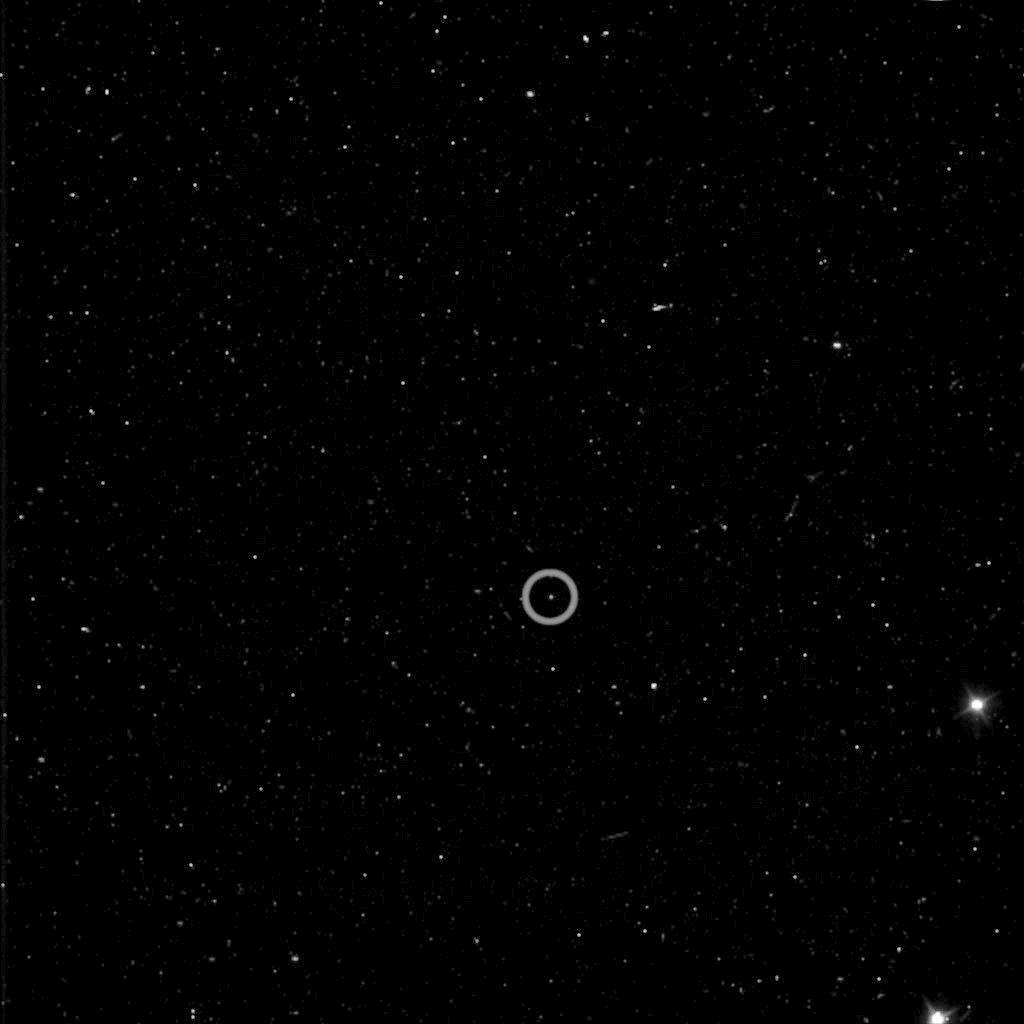 |
Images: Calibrated example image (2x zoom; Albiorix is marked by the circle) ISS_210OT_ALBPOL077 2014-Nov-24 |
| .gif |  |
Movie: Animated gif (loop) from clear-filter images of the closest observation ISS_136OT_ALBROT045 2010-Aug-12 |
| .jpg | 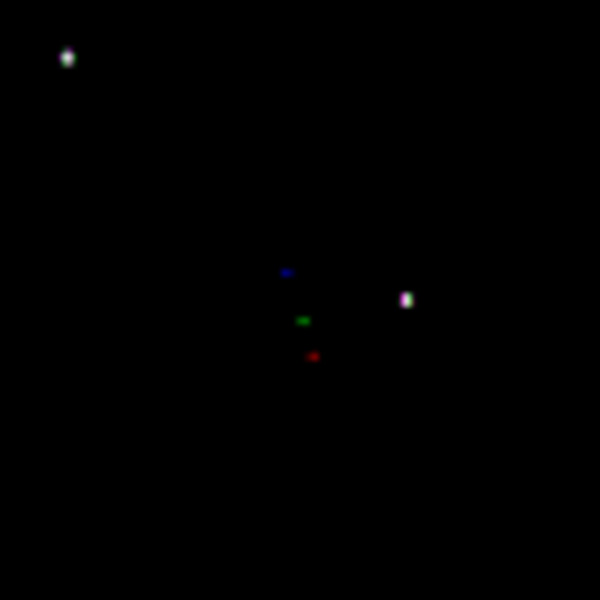 |
Images: Three Albiorix images displayed in red, green, and blue channels, 6x zoom. The moon moves in front of the fixed star background. ISS_136OT_ALBROT045 2010-Aug-12 |
| .jpg | 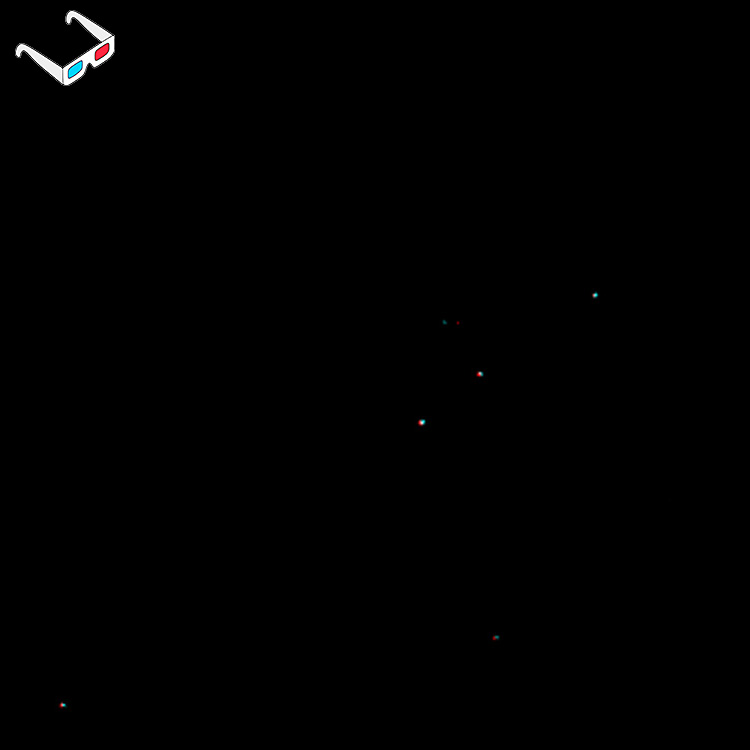 |
Artwork: Artificial anaglyph (3D) from two Cassini images — Albiorix is the spot in the foreground ISS_136OT_ALBROT045 N1660308074 and 08194 2010-Aug-12 |
| .zip | [ #.# MB ] | Movie: mp3 example [ not yet available ] |
| .zip | [ ### MB ] | Movie: All movies, in .mov format (→ lists in section (4) and sheet (8A) for observation-request names and details) [ not yet available ] |
Note: SCET/UTC…Spacecraft Event Time/ Coordinated Universal Time
(4) Lightcurves
General:
– Available
– References: Denk and Mottola (2019); Denk et al. (2018)
Major scientific results:
– Rotation period (sidereal): 13.33 ± 0.03 h = 13 h 20 m ± 2 m
– Substantial lightcurve amplitudes presumably due to irregular shape
– 2-max/2-min lightcurve extrema pattern; 3-max/3-min for a very high phase observation
– Likely not a double object
Lightcurve plots:
– Table of high-level observation details → sheet (8A)
– Data files are provided in text format
| Request-ID | Obs. date | Phase | Lightcurve | Data | Notes and references |
| ISS_136OT_ALBROT045 ISS_192OT_ALBPOLA103 ISS_192OT_ALBPOLB103 ISS_192OT_ALBPOLC103 ISS_210OT_ALBPOL077 ISS_210OT_ALBPOL073 |
12 Aug 2010 12 Jun 2013 12 Jun 2013 15 Jun 2013 24 Nov 2014 26 Nov 2014 |
45° 105° 105° 101° 77° 73° |
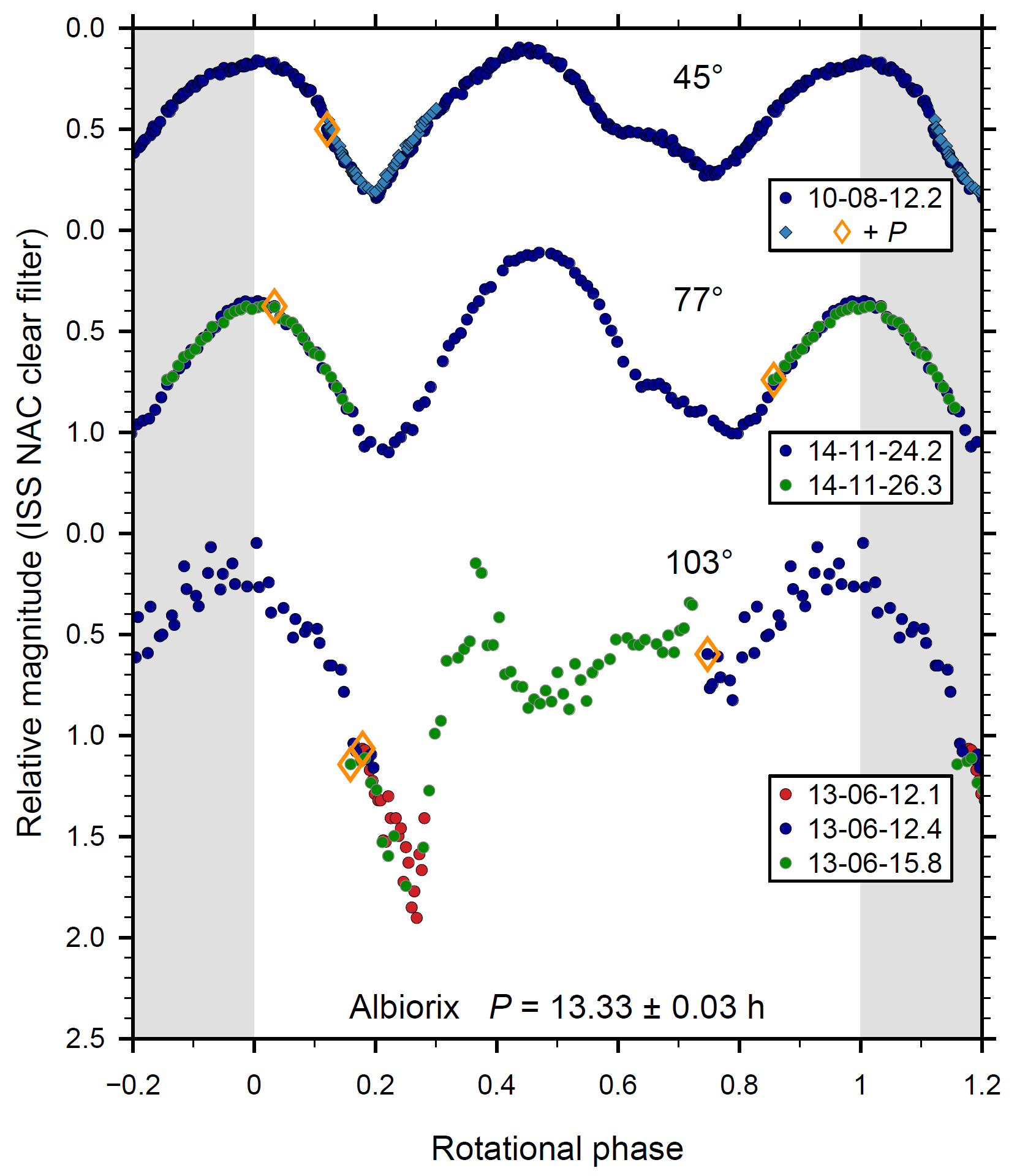 |
Denk and Mottola (2019) Symbol assignments: Orange diamonds: First observation measurement points; the start times are given in the legend boxes. 45° curve: covers slightly more than one rotation cycle; the 2nd cycle got a different symbol. |
(8) Cassini ISS observations: Planning
Table of contents:
(8A) Table: Albiorix observations overview
(8B) Map: Albiorix in the sky of Cassini
(8C) Albiorix geometry and visibility graph (range, phase, and magnitude vs. time)
General overview on ISS planning
→ sheet (2B)
High-level camera planning commands
![]() (includes most IOI files plus post-downlink notes) [ not yet available ]
(includes most IOI files plus post-downlink notes) [ not yet available ]
Fail notes (Cassini ISS)
– ISS_211OT_ALBCOL005 (17 Jan 2015): Albiorix is overexposed in all images except in all Uv3, 69% of Bl1, one Ir2, and all Ir3 filter images (because of wrong gain-state settings).
– ISS_236OT_ALBPOL121 (25 May 2016): 16% data loss due to “lateinthegame” data recorder space and data downlink time reductions (23 Albiorix images at observation start and 27 at end were lost) (from a total of 306 images).
(8A) Table: Albiorix observations overview
 Observational circumstances and geometry information for six ISS observation requests of Albiorix. From Table 2 of Denk and Mottola (2019), plus additional data. Information for requests not used in this paper will follow at a later date.
Observational circumstances and geometry information for six ISS observation requests of Albiorix. From Table 2 of Denk and Mottola (2019), plus additional data. Information for requests not used in this paper will follow at a later date.
Corresponding lightcurves → section (4)
![]() ← Table (8A) in text format
← Table (8A) in text format
Notes:
a The naming scheme used for Cassini Solstice Mission observations (“requests”) gives information on the object (first three letters), the request’s primary goal (Rot=rotation period; Pol=pole-axis/shape), and the approximate observation phase angle (three digits). The three digits between the first and the second underline indicate Cassini’s orbit number. “OT” stands for “other target”.
b Rev. = revolution = Cassini orbit number. in = apoapsis segment inbound, out = apoapsis segment outbound, peri = periapsis segment. Note that (for some reasons) the true number of orbits since Saturn arrival in 2004 is off (ahead) by 1.5 compared to the official count which is noted here and used in all technical aspects.
c Time difference between shutter mid-time of first and of last image used for the lightcurve.
d A uniform Earth-to-object distance of 1.319·109 km (range at opposition in April 2013) is used here for the distance between the irregular moons and Earth.
e For full-resolution images. The values must be doubled when the NAC was operated in 2×2 summation mode.
f Calculated from the absolute magnitude H, the observation phase angle α, and the distances of Albiorix to the sun and to Cassini.
g Coordinates of the irregular moons (geocentric RA/Dec and ecliptic λ/β) as seen from Cassini during the observations, see also sheet 8B.
h Phase-angle bisector vector (longitude and latitude). For definition and use, see appendix in Harris et al. (1984).
(8B) Map: Albiorix in the sky of Cassini
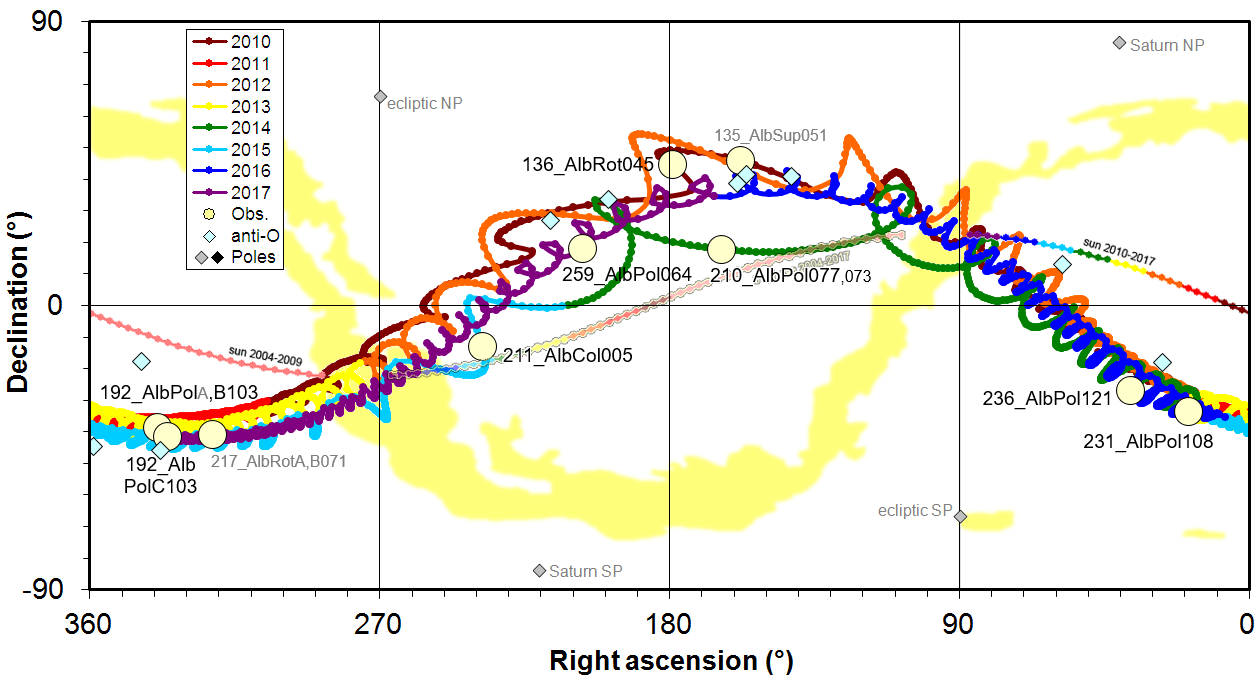 Albiorix as visible to Cassini between 2010 and 2017. Orthographic projection of the sky; geocentric coordinate system (RA/Dec). As a prograde object, Albiorix moves from right to left.
Albiorix as visible to Cassini between 2010 and 2017. Orthographic projection of the sky; geocentric coordinate system (RA/Dec). As a prograde object, Albiorix moves from right to left.
Shown are Albiorix’s locations (colored, wiggled lines), the Albiorix locations during Cassini observations (light-yellow circles with annotations), the anti-directions of the Cassini observations (bluish diamonds), the location of the sun from 2004 to 2017 (smooth sinusoidal line from RA ∼ 290° to ∼ 85°; the sun moves from right to left), the location of the anti-sun (0° phase) from 2004 to 2017 (pale sinusoidal line from RA ∼ 110° to ∼ 265°), the Milky Way (yellow band) and the Magellanic clouds (yellow spots to the lower right), the ecliptic poles (gray diamonds), and Saturn’s poles (gray diamonds).
NP = north pole; SP = south pole.
(8C) Albiorix geometry and visibility graph
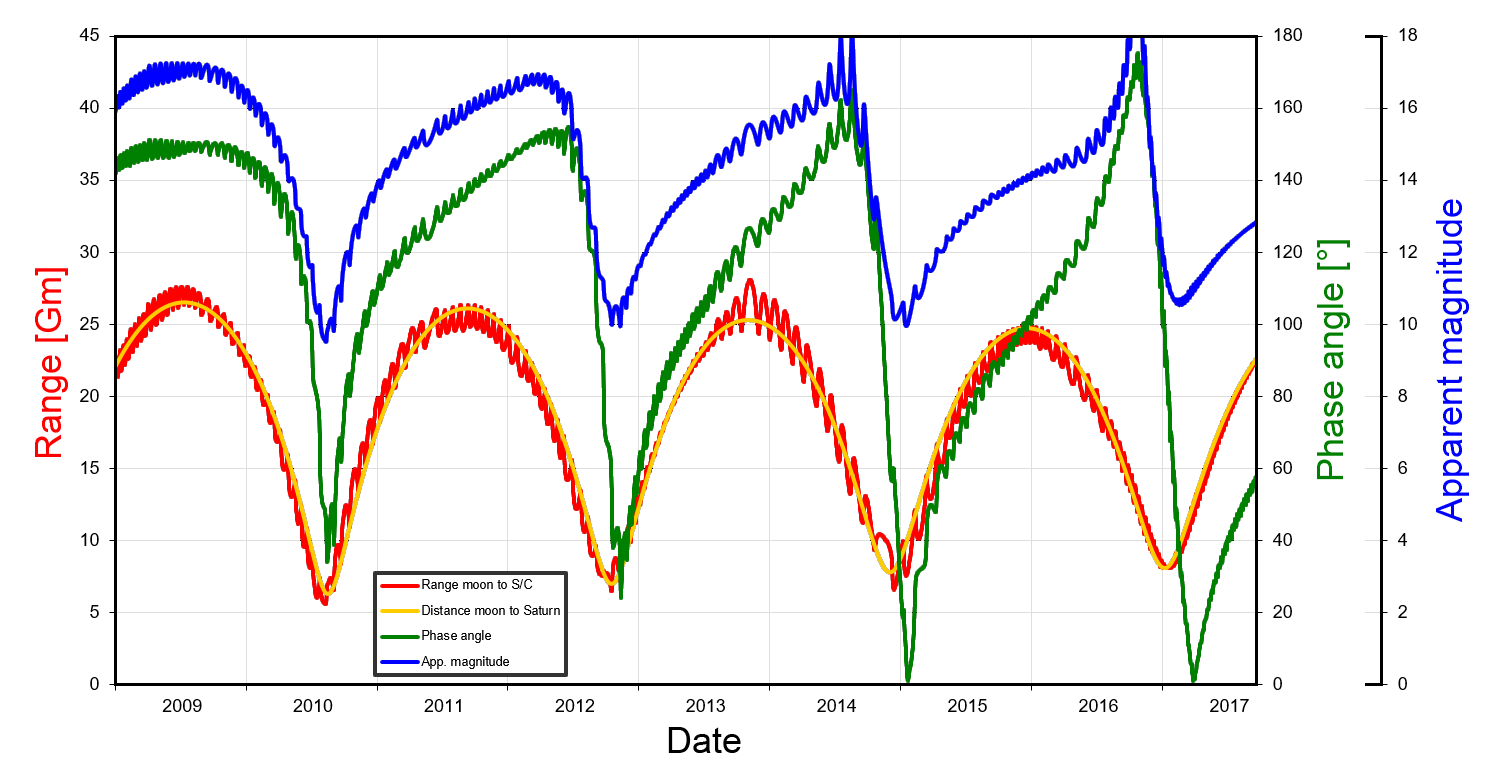 This graph has been used for Albiorix observation scheduling.
This graph has been used for Albiorix observation scheduling.
Notes: Left axis: Range of Albiorix to Cassini (red) and to Saturn (orange); right axes: phase angle (green) and apparent magnitude of Albiorix (blue) as seen from Cassini for the time range 01 Jan 2009 to 15 Sep 2017 (end-of-mission).
(9) References for Albiorix
IAU circular, discovery: no. 7545
IAU circular, naming: no. 8177
Wikipedia: ![]() Albiorix (moon)
Albiorix (moon) ![]() Albiorix (Mond)
Albiorix (Mond)
My ‘Outer Moons of Saturn’ website: Sheet ‘links and references’
References (that include my work)
| Denk, T., Mottola, S. (2019): Studies of Irregular Satellites: I. Lightcurves and Rotation Periods of 25 Saturnian Moons from Cassini Observations. Icarus 322, 80-103. doi:10.1016/j.icarus.2018.12.040 | |
| Denk, T., Mottola, S., Tosi, F., Bottke, W.F., Hamilton, D.P. (2018): The Irregular Satellites of Saturn. In: Enceladus and the Icy Moons of Saturn (Schenk, P.M., Clark, R.N., Howett, C.J.A., Verbiscer, A.J., Waite, J.H., editors), Space Science Series, The University of Arizona Press, pp. 409-434. |
References (work from colleagues)
© Tilmann Denk (2022)
